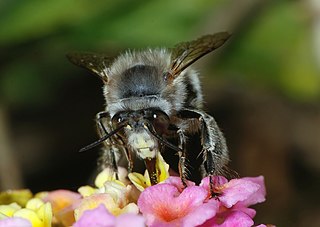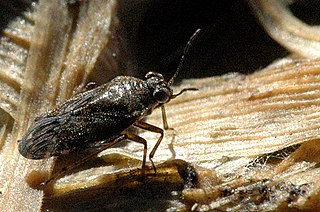Related Research Articles

Entomology is the scientific study of insects, a branch of zoology. In the past the term insect was less specific, and historically the definition of entomology would also include the study of animals in other arthropod groups, such as arachnids, myriapods, and crustaceans. This wider meaning may still be encountered in informal use.

A water beetle is a generalized name for any beetle that is adapted to living in water at any point in its life cycle. Most water beetles can only live in fresh water, with a few marine species that live in the intertidal zone or littoral zone. There are approximately 2000 species of true water beetles native to lands throughout the world.

The Haliplidae are a family of water beetles that swim using an alternating motion of the legs. They are therefore clumsy in water, and prefer to get around by crawling. The family consists of about 200 species in 5 genera, distributed wherever there is freshwater habitat; it is the only extant member of superfamily Haliploidea. They are also known as crawling water beetles or haliplids.
Benjamin Dann Walsh was an English-born American entomologist who served as the first official state entomologist in Illinois. He was a leading influence during a time of significant transition in American entomology. Walsh championed the application of scientific methods to control agricultural pests. He was a proponent of biological control as an effective means to manage insects. He was also one of the first American scientists to support Charles Darwin's theory of evolution and was instrumental in securing its broad acceptance in the entomological community.

Rhopalosomatidae is a family of Hymenoptera containing about 68 extant species in four genera that are found worldwide. Three fossil genera are known.

Samuel Wendell Williston was an American educator, entomologist, and paleontologist who was the first to propose that birds developed flight cursorially, rather than arboreally. He was a specialist on the flies, Diptera.

The bee genus Anthophora is one of the largest in the family Apidae, with over 450 species worldwide in 14 different subgenera. They are most abundant and diverse in the Holarctic and African biogeographic regions. All species are solitary, though many nest in large aggregations. Nearly all species make nests in the soil, either in banks or in flat ground; the larvae develop in cells with waterproof linings and do not spin cocoons. Males commonly have pale white or yellow facial markings, and/or peculiarly modified leg armature and hairs. Anthophora individuals can be distinguished from the very similar genus Amegilla by the possession of an arolium between the tarsal claws.
Charles Paul Alexander was an American entomologist who specialized in the Tipulidae family of craneflies.

Saldidae, also known as shore bugs, are a family of insects in the order Hemiptera. They are oval-shaped and measure 2–8 mm (0.08–0.31 in) when mature. Typically they are found near shorelines or the marginal growths near freshwater bodies, estuaries, and sea coasts. They can flee by leaping or taking flight. There are about 350 recognized species with the majority from the Nearctic and Palearctic. Many species are found in the intertidal zone and both adults and nymphs of some species like Saldula pallipes can tolerate submergence at high-tide. Saldidae are predators and scavengers. They pass the winter through egg or adult diapause.
Ororaphidia is an extinct genus of snakefly containing two species: the type species Ororaphidia megalocephala and Ororaphidia bifurcata.
Hungerford's crawling water beetle is a critically endangered member of the family Haliplidae of water beetles found in northeastern North America. The US Fish and Wildlife Service Draft Recovery Plan for the species published in August 2004 estimates roughly 1000 individuals are present in the wild. In 2010, a five-year summary report by the United States Fish and Wildlife Service found the population to be essentially unchanged.

John Merton Aldrich was an American entomologist. Aldrich was the Associate Curator of Insects at the United States National Museum. He is considered one of the most prolific entomologists in the study of flies.

Brychius is a genus of beetles in the family Haliplidae, containing the following species:
Brychius glabratus is a species of beetle in the genus Brychius, discovered by two Villa siblings in 1835.

Brychius elevatus is a species of beetle in the genus Brychius that was first described by Panzer in 1793.

Heriades is a genus of bees in the family Megachilidae. Fairly small and usually black, they are found all over the world. There are more than 130 species worldwide, roughly 25 species in North and Central America, but only 3 species are native east of the Rocky Mountains. European species such as H. truncorum can be found on the east coast of the US. Like other bees in the tribe Osmiini, Hoplitis and Ashmeadiella, they nest in cavities in wood excavated by other insects, or perhaps occasionally pine cones. They separate the cells of their nest with resin .
Prokelisia marginata is a species of delphacid planthopper in the family Delphacidae. It is found in North America.

Aspidytidae is a family of aquatic beetles of the suborder Adephaga, described in 2002 from specimens in South Africa and China. There are only two known species in the family and these were originally described in the genus Aspidytes, but later the new genus Sinaspidytes was erected for the species found in China. The family can also be referred to by its trivial name cliff water beetles.
Pseuduvarus vitticollis, is a species of predaceous diving beetle found in India, Nepal, Pakistan, Sri Lanka, China, Madagascar, Malaysia, Taiwan and African region.

Gyrinus gibbus is a species of aquatic beetle in the family Gyrinidae. It is native to the Neotropics.
References
- ↑ "Haliplidae Species List". Joel Hallan's Biology Catalog. Texas A&M University. Retrieved 10 May 2012.
- ↑ Durfee, Richard S.; Jasper, Sharon Knight; Kondratieff, Boris C. (2005). "Colorado Haliplidae (Coleoptera): Biogeography and Identification". Journal of the Kansas Entomological Society. 78 (1). Kansas (Central States) Entomological Society: 41–70. ISSN 0022-8567. JSTOR 25481805 . Retrieved 2024-10-22.